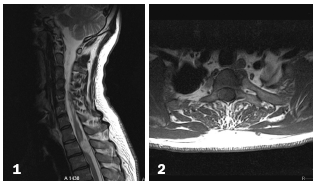Intradural extramedullary schwannoma
A 40-year-old man presented with a 10-month history ofepisodic cervical pain radiating to the left shoulder. Symptoms had become persistent over the past month and functional impairment was evident in the left arm.
CLINICAL HISTORY
A 40-year-old man presented with a 10-month history of episodic cervical pain radiating to the left shoulder. Symptoms had become persistent over the past month. Functional impairment was evident in his left arm.
FINDINGS

Sagittal T2-weighted and unenhanced axial T1-weighted MRI both show a well-marginated nodular lesion in the intradural extramedullar space at the T2 level (Figure 1), with a broad contact surface between the lesion and the posterior and left lateral wall of the upper thoracic spinal canal. The spinal canal is largely occupied by the lesion, causing the cord to be severely compressed and displaced to the right (Figure 2). The mass is homogeneously hypointense on T1-weighted images. It is hyperintense, though somewhat heterogeneous, on T2-weighted images.
Moderate and heterogeneous enhancement is depicted after contrast administration, with no dural tail or foraminal/ extracanal extension (Figures 3 and 4).
DIAGNOSIS
Intradural extramedullary schwannoma (neurinoma). Differential diagnoses include solitary neurofibroma, meningioma, extruded disc fragment, lateral meningocele, and myxopapillary ependymoma.1
DISCUSSION

Schwannoma, also known as neurinoma or neurilemmoma, is a neoplasm of the nerve sheath in the peripheral nervous system. It is the most common intradural extramedullary lesion, accounting for 30% of all primary spine neoplasms. Incidence is sporadic, although it is linked to some inherited tumor syndromes (neurofibromatosis [NF2], schwannomatosis, Carney complex). The most common symptoms are a combination of progressive myelopathy and/or radiculopathy. It affects men and women equally, with a peak incidence in the 40 to 60-year-old age group.2,3
Gross pathology shows a circumscribed, well-encapsulated, light tan/yellow, round/ovoid mass that may have cysts. Hemorrhage and frank necrosis are uncommon.
Schwannoma is a grade I tumor, according to the World Health Organization classification. It appears as a slowgrowing, well-delineated, enhancing spinal nerve root mass. In 70% to 75% of cases, it is located in the intradural extramedullary compartment. The tumor is completely extradural in 15% of cases and depicts a dumbbell configuration (combined intra- and extradural involvement) in the remainder of cases. The majority of tumors are small, measuring from a few millimeters to one or two vertebral segments, though multisegmental giant schwannomas can occur as well.
Unenhanced CT shows a sharply delineated isodense mass with a cord. Cysts are common. Hemorrhage and calcification are rare. Remodeling of adjacent bone with scalloping of the posterior vertebral body can be seen in large lesions. The neuronal foramen enlarges with dumbbell lesions. A moderate solid/rim enhancement is typically seen after contrast administration.
Digital subtraction angiography shows variable vascularity (none to moderate).
MRI findings include hypointensity relative to the spinal cord on T1-weighted images, and hyperintensity on T2- weighted images, with an occasional target pattern (high signal rim, low intensity center).4 Cysts can be seen in 40% of cases. Tumors generally enhance intensely after contrast with a uniform or heterogeneous pattern.
Asymptomatic patients with suspected NF2 should have their entire spine imaged.
The advised treatment for schwannoma is total microsurgical resection.5 Neurological deficit should improve after surgery. Prognosis is good and tumors do not typically recur, except in cases of NF2 and schwannomatosis. A solitary schwannoma will rarely show malignant degeneration. The risk is higher for patients with NF2.
Case submitted by Dr. Pilar Piñero, Virgen del Rocío, University Hospital, Seville, Spain.
The Reading Room Podcast: Current Perspectives on the Updated Appropriate Use Criteria for Brain PET
March 18th 2025In a new podcast, Satoshi Minoshima, M.D., Ph.D., and James Williams, Ph.D., share their insights on the recently updated appropriate use criteria for amyloid PET and tau PET in patients with mild cognitive impairment.
GE HealthCare Debuts AI-Powered Cardiac CT Device at ACC Conference
April 1st 2025Featuring enhanced low-dose image quality with motion-free images, the Revolution Vibe CT system reportedly facilitates improved diagnostic clarity for patients with conditions ranging from in-stent restenosis to atrial fibrillation.